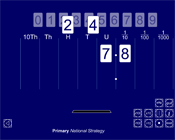Consolidation and practice
These resources are to support children in guided or independent work. Roll over the highlighted resource for a description.
Moving digits

This interactive teaching program (ITP) is an ICT-based tool to support the exploration of place value. Moving digits ITP allows the child or teacher to place and move digits on a place value board, investigating the effects of multiplying and dividing by 10 or 100.
Opportunities to use and apply
Possible contexts include:
- money, e.g. How many pennies would have the same value as 12 ten-pence coins? How many pennies would have the same value as 12 £1 coins? How many ten-pence coins would be worth the same as three £1 coins?
- calculations, e.g. Use knowledge of multiplying by 10 to solve calculations such as 3 × 20 (3 × 10 × 2).
- measures, e.g. How many centimetres are in 5 m, 8 m,
10 m? There are 10 mm in 1 cm. Paul draws a line 7½ cm long. How could you work out how many millimetres this is?
Confirming learning
Ask probing questions such as:
- Josh says that 31 multiplied by 10 is 301. Is he right? Explain how you know.
- What operation would you key into the calculator to turn 74 into 740?
- What happens to the digits of a number when you multiply it by 10? What happens when you multiply it by 100?
- Ann multiplies six by 10, then multiplies the answer by 10. What is the final answer? How many times bigger than six is this number?
- Fill in the empty boxes.

 tens
tens Calculating
Calculating

